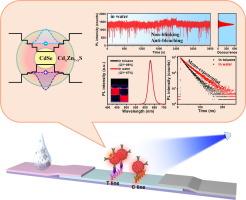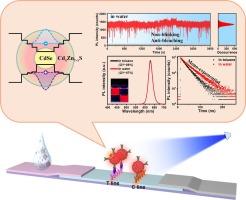合金几何结构策略实现了用于超灵敏荧光免疫分析的高质量水溶性量子点
IF 13.3
1区 工程技术
Q1 ENGINEERING, CHEMICAL
引用次数: 0
摘要
护理点诊断行业的快速进步和发展为开发新型信号标签以进行高灵敏度生物分子检测提供了动力。胶体量子点(QDs)具有卓越的亮度、简便的表面功能化和优异的光稳定性,因此成为这些生物应用的首选。然而,在复杂的生物环境中,量子点的荧光强度明显降低,光化学稳定性有限,这极大地阻碍了它们的进一步应用。在本文中,通过创新的合金工程策略,获得了高质量的水溶性 CdSe/CdxZn1-xS QDs,其聚合光量子产率接近统一,且具有单指数聚合光衰减动力学特性。值得注意的是,首次实现了单个 QD 在水中破纪录的稳定性,其一小时不眨眼的特性接近最先进的疏水性 QD。此外,用这些新型合金 QDs 配制的纳米复合材料显示出 96% 的显著 PL QY,并能在侧流免疫分析中对前列腺特异性抗原进行超灵敏检测。本文介绍的这些发现为设计单分子水平的高亮度水溶性 QDs 和基于 QDs 的纳米复合材料提供了新的思路,极大地推动了高灵敏度生物医学检测和诊断的发展。本文章由计算机程序翻译,如有差异,请以英文原文为准。


Alloyed geometric structure strategy enables high-quality water-soluble quantum dots for ultrasensitive fluorescence immunoassay
The rapid advance and growth of the point-of-care diagnosis industry has provided an impetus for the development of novel signal labels for highly sensitive bio-molecule detections. Colloidal quantum dots (QDs) exhibit superior brightness, facile surface functionalization and exceptional photostability, making them the preferred option for these biological applications. However, the significantly reduced fluorescence intensity and limited photochemical stability in complex biological environments have greatly hampered their further use. Herein, with an innovative alloying engineering strategy, the high-quality water-soluble CdSe/CdxZn1−xS QDs with near-unity PL quantum yield and monoexponential PL decay dynamics are obtained. Notably, for the first time, a record-breaking stability at the single QD level in water with nonblinking behavior persisting for an hour is achieved, which approaching those of state-of-the-art hydrophobic QDs. Furthermore, the nanocomposites formulated with these novel alloyed QDs demonstrate a remarkable PL QY of 96 % and provide an ultrasensitive detection for prostate specific antigen on lateral flow immunoassays. These findings presented here shed new light on the design of high-brightness water-soluble QDs in single-molecule level and QDs-based nanocomposites, significantly pushing ahead toward high-sensitivity biomedical detections and diagnosis.
求助全文
通过发布文献求助,成功后即可免费获取论文全文。
去求助
来源期刊

Chemical Engineering Journal
工程技术-工程:化工
CiteScore
21.70
自引率
9.30%
发文量
6781
审稿时长
2.4 months
期刊介绍:
The Chemical Engineering Journal is an international research journal that invites contributions of original and novel fundamental research. It aims to provide an international platform for presenting original fundamental research, interpretative reviews, and discussions on new developments in chemical engineering. The journal welcomes papers that describe novel theory and its practical application, as well as those that demonstrate the transfer of techniques from other disciplines. It also welcomes reports on carefully conducted experimental work that is soundly interpreted. The main focus of the journal is on original and rigorous research results that have broad significance. The Catalysis section within the Chemical Engineering Journal focuses specifically on Experimental and Theoretical studies in the fields of heterogeneous catalysis, molecular catalysis, and biocatalysis. These studies have industrial impact on various sectors such as chemicals, energy, materials, foods, healthcare, and environmental protection.
 求助内容:
求助内容: 应助结果提醒方式:
应助结果提醒方式:


